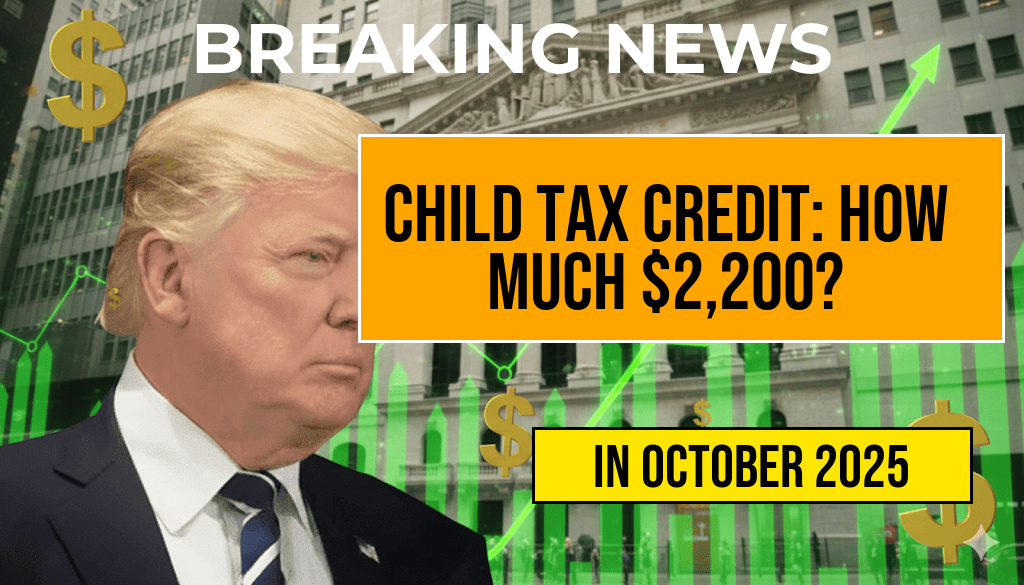Understanding the Additional Child Tax Credit of $2,200: How Much Can Your Family Expect?
Families across the United States are now scrutinizing how recent tax reforms and relief measures impact their finances, especially regarding child-related credits. One notable change is the supplemental Child Tax Credit (CTC) of up to $2,200 per qualifying child, which provides significant relief for eligible families. This additional credit is designed to supplement the standard child tax benefit, offering an extra financial boost to help cover expenses such as childcare, education, and daily needs. The actual amount families will receive hinges on several factors, including income level, filing status, and the number of qualifying children. As tax season approaches, understanding how this credit works and how much families can expect to receive becomes increasingly essential for financial planning and budgeting.
What Is the Additional Child Tax Credit?
Overview of the $2,200 Enhancement
The additional Child Tax Credit (ACTC) was introduced to expand support for families with children, especially those with lower to moderate incomes. Under recent legislation, qualifying families can claim an extra $2,200 per child, which is in addition to the standard child tax credit. This enhancement aims to reduce child poverty and assist families in managing rising costs of living.
Eligibility Criteria
- Children must be under 17 at the end of the tax year.
- Taxpayers must have earned income above a certain threshold to qualify for the full benefit.
- Adjusted gross income (AGI) limits vary depending on filing status, but generally, higher-income families see a phase-out of the credit.
Calculating the Expected Benefit
How Your Income Affects the Credit
The amount of $2,200 is not automatically granted to all families with children; instead, it phases out as income increases. Families with lower incomes typically qualify for the full amount, while higher earners see a gradual reduction. The phase-out begins once income exceeds certain thresholds, which vary based on filing status. For example, in 2023, the phase-out threshold for single filers is around $75,000, while for married couples filing jointly, it starts at approximately $150,000.
The Impact of Family Size
Each qualifying child under 17 can generate a maximum $2,200 credit. Families with multiple children can multiply this benefit, significantly reducing their tax liability or increasing their refund. To illustrate, a family with three children under 17 could potentially receive up to $6,600 in additional credits, depending on their income and filing status.
Practical Examples of Benefit Calculation
| Number of Children | Family Income | Estimated Additional Child Tax Credit |
|---|---|---|
| 1 | $50,000 | $2,200 |
| 2 | $80,000 | Approximately $1,100 per child (phase-out begins) |
| 3 | $160,000 | Partial benefit, reduced from maximum |
Note that actual amounts depend on individual circumstances, including other credits and deductions claimed during tax filing. Families can consult IRS tools or professional tax preparers for precise calculations.
How to Maximize Your Child Tax Credits
Key Steps for Families
- Ensure accurate reporting of dependents to qualify for the full benefit.
- Maintain documentation such as birth certificates and proof of income.
- Use IRS resources like the Child Tax Credit worksheet to estimate potential refunds.
- Consider timing—filing early can expedite receiving refunds, especially if you qualify for advance payments.
Additional Resources and Support
Families seeking more detailed information can visit the IRS Child Tax Credit page or consult reputable financial advisory sites like Forbes for updates on policy changes and planning tips.
Implications for Families and Policy Trends
The enhancement of the Child Tax Credit, including the supplementary $2,200 per child, reflects ongoing efforts to support working families and reduce disparities. While the specifics can vary yearly based on legislative adjustments, the current framework offers tangible benefits to millions of households. As discussions about future tax reforms continue, families should stay informed about potential changes that could influence eligibility and benefit amounts.
Understanding the criteria and calculation methods for the $2,200 additional child credit empowers families to plan their finances more effectively. Whether through maximizing deductions or ensuring proper documentation, these steps can help families unlock the full potential of available tax relief.
Frequently Asked Questions
What is the Additional Child Tax Credit of $2,200?
The Additional Child Tax Credit of $2,200 is a refundable tax credit designed to provide extra financial support to eligible families with qualifying children, helping to reduce their overall tax liability and potentially resulting in a refund.
How do I determine if my family qualifies for the $2,200 Child Tax Credit?
Eligibility for the Child Tax Credit depends on factors such as your family’s income level, number of qualifying children, and your filing status. The IRS provides specific criteria, including age and relationship requirements for children, to determine if you qualify for the $2,200 amount.
How is the additional $2,200 Child Tax Credit calculated on my tax return?
The credit amount of $2,200 is typically calculated based on your income and tax liability. If your tax owed is less than the credit amount, you may be eligible for a refund of the remaining balance through the Additional Child Tax Credit.
Can I claim the $2,200 Child Tax Credit if I received other benefits or credits?
Yes, the Additional Child Tax Credit can be claimed in addition to other tax credits or benefits, such as the Earned Income Tax Credit. However, your total credits may be subject to certain income limits and phase-outs.
How can I maximize my family’s benefit from the $2,200 Child Tax Credit?
To maximize your benefit, ensure you meet all eligibility criteria, accurately report your income and qualifying children, and consider consulting a tax professional for strategies to optimize your tax refund related to the Child Tax Credit.








